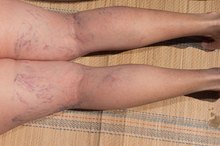What does fact checked mean?
At Healthfully, we strive to deliver objective content that is accurate and up-to-date. Our team periodically reviews articles in order to ensure content quality. The sources cited below consist of evidence from peer-reviewed journals, prominent medical organizations, academic associations, and government data.
The information contained on this site is for informational purposes only, and should not be used as a substitute for the advice of a professional health care provider. Please check with the appropriate physician regarding health questions and concerns. Although we strive to deliver accurate and up-to-date information, no guarantee to that effect is made.
Anywhere there are veins and arteries, internal blood clots can and do form. This includes the feet. Blood clots are not uncommon in the foot, just as they are not uncommon in the lower leg and calf. Sometimes a foot pain is more than just pain--it's the sign of a blood clot, and since blood clots can sometimes be fatal or lead to a heart attack or stroke, it is very important to have them diagnosed.
If you are experiencing serious medical symptoms, seek emergency treatment immediately.
Definition of an Internal Blood Clot
Blood clotting is a process in which platelets and red blood cells along fibrin, a type of protein, form a clump to stop bleeding after a blood vessel has been injured. Scabbing occurs when this process happens at the surface of the skin. Internal clotting, or clotting that takes place inside a blood vessel, can be dangerous. Although most clots that form will be dissolved by the body naturally, one that continues to form inside a vein or artery can get to to point that it blocks blood flow.
- Blood clotting is a process in which platelets and red blood cells along fibrin, a type of protein, form a clump to stop bleeding after a blood vessel has been injured.
Blood Clots in the Feet
Popliteal Aneurysm Symptoms
Learn More
Blood clots in the feet occur for much the same reasons that they do in any other part of the body. Obesity, activity level, genetic factors, viral infections, recent surgery, smoking, age--all of these factors can contribute to the formation of a blood clot. Blood clots in the feet have a similar risk factor to developing clots in the legs. The main concern is that it will break free in the vein in the foot where it formed and will travel to arteries in other parts of the body such as:
- stroke
- pulmonary embolism
- heart attack
- Blood clots in the feet occur for much the same reasons that they do in any other part of the body.
- Blood clots in the feet have a similar risk factor to developing clots in the legs.
Dangers of a Blood Clot
When blood clots internally, inside a vein or artery, it can block blood flow. Depending on where this occurs in the body, it can lead to a heart attack or stroke. Blood clots can break off from where they originally form and travel to other parts of the body, such as the heart, brain or lungs. A blood clot blocking an artery in the lung leads to pulmonary embolism, which sometimes can prove fatal.
- When blood clots internally, inside a vein or artery, it can block blood flow.
- Blood clots can break off from where they originally form and travel to other parts of the body, such as the heart, brain or lungs.
Symptoms of Blood Clots in the Feet
What Causes Feet to Swell?
Learn More
Blood clots in the feet can cause redness or swelling of the feet, in addition to numbness of the affected foot. A throbbing pain in the foot that does not go away with rest may also be a sign of a blood clot that has formed in the foot. If you experience a sharp, shooting pain when you flex your foot, this may also be a sign of a blood clot. There may also be a widening of the veins at the surface of the foot.
- Blood clots in the feet can cause redness or swelling of the feet, in addition to numbness of the affected foot.
- A throbbing pain in the foot that does not go away with rest may also be a sign of a blood clot that has formed in the foot.
Treatment and Prevention of Blood Clots
Blood thinner can be taken to prevent blood clots from forming. Aspirin is an over-the-counter blood thinner. Once a blood clot is confirmed by a doctor, a shot of the drug Heparin is often administered. Another prescription drug to eliminate blood clots is Warfarin, which is taken orally. Always consult your doctor before beginning any drug regimen.
- Blood thinner can be taken to prevent blood clots from forming.
- Another prescription drug to eliminate blood clots is Warfarin, which is taken orally.
Related Articles
References
- National Library of Medicine
- Mayo Clinic
- American Society of Hematology. Blood Clots.
- Litvinov RI, Weisel JW. What Is the Biological and Clinical Relevance of Fibrin?. Semin Thromb Hemost. 2016;42(4):333-43. doi:10.1055/s-0036-1571342
- American Heart Association. Understand Your Risk for Excessive Blood Clotting.
- Adivitiya, Khasa YP. The evolution of recombinant thrombolytics: Current status and future directions. Bioengineered. 2017;8(4):331-358. doi:10.1080/21655979.2016.1229718
- Fields JM, Davis J, Girson L, et al. Transthoracic Echocardiography For Diagnosing Pulmonary Embolism: A Systematic Review And Meta-Analysis. J Am Soc Echocardiogr 2017; 30:714. doi:10.1016/j.echo.2017.03.004
- Gibson NS, Schellong SM, Kheir DY, et al. Safety And Sensitivity Of Two Ultrasound Strategies In Patients With Clinically Suspected Deep Venous Thrombosis: A Prospective Management Study. J Thromb Haemost 2009; 7:2035. doi:10.1111/j.1538-7836.2009.03635.x
- National Blood Clot Alliance. Signs and Symptoms of Blood Clots.
- Weitz JI, Fredenburgh JC, Eikelboom JW. A Test In Context: D-Dimer. J Am Coll Cardiol 2017; 70:2411. doi:10.1016/j.jacc.2017.09.024
Writer Bio
Antonia Sorin started writing in 2004. She is an independent writer, filmmaker and motion graphics designer based in Raleigh, North Carolina. She has completed work for the Long Leaf Opera Company, the former Exploris Museum and the Leukemia and Lymphoma Society. She graduated from Thomas Edison State College in New Jersey with a Bachelor of Arts in communications.








